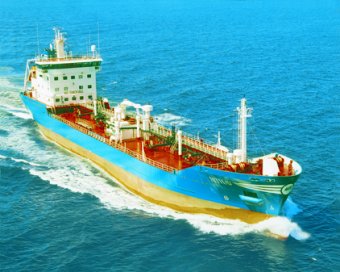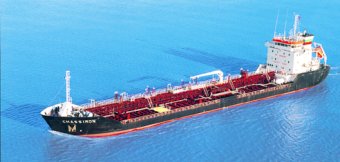
The Shipbuilding market in 2000 (6)
|
|
|
|

|
|
The two shipyards in Finland Aker-Finnyards
and Kvaerner-Masa remain concentrated on the production of passenger
vessels, ro-pax and ferries for the former and exclusively of cruise ship
newbuilding for the latter.
Aker-Finnyards succeeded in securing four ferry orders for the account
of foreign shipowners: SeaFrance, Tallink and Hesbrides Islands.
Kvaener-Masa for its part firmed up its orderbook with three newbuildings
for Carnival Corp. and two for Royal Caribbean Cruises.
|
|
|

|
|
The nineties were marked by the closing of
many shipyards in Denmark, such as Burnmeister and Wain and Svendborg in
1996, North Sea Shipyard in 1997 Aarhus Flydedok in 1999 and Danyard in
2000.
The only significant remaining shipyards are Odense and Orskov, this
latter which has taken over some of the activities of Danyard.
The Association of Danish Shipbuilders has expressed concern that the
disappearance of Danish shipyards could have a domino effect on the other
segments of the maritime industry in Denmark, similar to what happened in
Great Britain or Sweden and that the Danish expertise in the maritime
sector will fade away over time.
|
|
|

|
 |
BITHAV
6,400 dwt, built 2000, high heat 250'C - owned by Tarbit Shipping
|
The orderbook for Holland is stable at about 598,000 gt as of the third
quarter 2000, with a distinctive feature of an important production of smaller
vessels, generally below 10,000 dwt.
Up to now, this specialisation in construction of all types but in small
sizes has shielded Dutch shipbuilders from some of the competition from Asian
shipyards, when supervision and positioning costs are factored over the
smaller size and earning power of these vessels. Competition has also been
avoided due to the fact that Korea's builders have targeted larger sizes.
Japan's shipyards for smaller sizes limit themselves to building for the
less demanding standards of their domestic owners.
However, the special niche in servicing the demand from European shipowners
for smaller sized vessels is now being challenged by many of the shipyards in
China who are very keen to build any size of vessel.
This challenge from China might be accelerated by the ending of
shipbuilding subsidies and the tax incentive schemes in place during the 1990's
for Dutch owners to build their fleets in Holland.
Shipbuilders in the Netherlands are being aggressively proactive compared
with other Europeans in using their expertise in design and project management
to a competitive advantage by combining their skills with the experienced low
labour cost in Eastern Europe. The Damen Group has been one of the leading
innovators in this trend of subcontracting the construction of hulls in
countries like Romania (where Damen has now taken control of the Galatz
shipyard) and then bringing the hulls for completion in Holland, Germany,
Norway or elsewhere.
This trend has already led to a sustained rebirth of shipbuilding in
Romania that is expected to expand to larger sizes and whole completed vessels
being built as standards and efficiency increase to internationally accepted
levels. A similar set of developments is already underway in Ukraine. There is
expectation that this trend of marrying Western finance, design, production
and management skills with post-Soviet collapse under utilised shipbuilding
capacity will accelerate, given the cost advantages obtainable and proximity
of the players involved and the customers they are serving.
 |
CHASSIRON
5,100 dwt, built 2000 by Niestern Sander - operated by Petromarine
|
|
|
|

|
|
The Norwegian shipyards have succeeded with a
remarkable performance in the year 2000 and have obtained almost 33
billion kroner's (about US$ 3.6 billion) worth of contracts. This figure
is a strong improvement over the 1999 contracts value of nine billion
kroner (about US$ one billion) and even more so over the 1998 results of
four billion kroner (about US$ 450 million).
Almost 15 billion kroner (about US$ 1.68 billion) of orders came from
the offshore sector which consisted of more than 70 orders for all types.
Another significant order was for an ocean going resort ship at Fosen
Shipyard. The Kleven Floroe shipyard was also successful in signing orders
for four large sized chemical tankers.
The owners who were willing to contract in Norway were able to benefit
from the weak exchange rate between the kroner and the dollar as well the
opportunity to take advantage of remaining shipbuilding subsidies
available for contracts signed before the end of 2000.
|
|
|

|
|
Croatian shipbuilding was able to profit from
the return of peace to the region as well as the saturation of shipyards
in Korea.
In the summer months of 2000 Croatian yards were able to offer delivery
dates much earlier than shipbuilders in the Far East at prices that were
competitive as well. These factors combined with Croatia's excellent
reputation and experience in building product carriers placed the country
in good position to participate in the new product tanker market cycle and
sign a number of orders from both Northern European and Mediterranean
shipowners.
Most noteworthy was the ability of Trogir, after a number of painful
years without orders to take numerous contracts for product tankers of
47,000dwt.
The Croatian orderbook as of the fourth quarter 2000 stood at about
970,000 gt (compared with 765,000 gt in 1999). There was a great deal of
active negotiation taking place in the fourth quarter 2000.
|
|
|

|
|
Polish shipbuilders also benefited from the
filling up of the Korean shipyards and the number of European owners,
especially Germans, who placed orders for container vessels. Poland
succeeded in doubling its orderbook in 2000 to 2.814 million gt (compared
with 1,490,000 gt in December 1999).
If Croatia was notable for the number of Mediterranean owners it
attracted, then Poland was even more successful in concluding business
with German, and Scandinavian owners looking for very specialised
newbuildings such as LPG tankers, product carriers and stainless steel
chemical carriers, ro-ros and ro-pax.
Poland's evolution into the top ranks of the world shipbuilders has
been accompanied by aggressive corporate restructuring, management
rationalisation, improved use of assets and expansion of capacity and
modernisation.
|
|
United States of America
|

|
|
The shipbuilding industry in the United States
experienced some interesting developments after a long decade of low
civilian newbuilding activity and less than one percent of the world
orderbook. The year 2000 saw an increase of the USA orderbook up to
1,020,000 gt.
Ingalls shipyard, is currently building two cruise ships for the
account of American Hawaiian / AMCV for delivery at the beginning of 2003
and 2004. This is an important development to follow and one, which, if
successfully concluded, could be the source of unexpected competition to
the European shipbuilders who presently dominate the special niche market
of cruiseship building.
Year 2000 also saw BP placing orders for three tankers of 185,000 dwt
with NASSCO (average price about US$ 210 million each). They were followed
by Polar Tankers who placed an order at Avondale.
The majority of the large American shipyards continue to survive in
servicing the needs of the US Navy. On the civilian side they operate
under the protection of the Jones Act which obliges the very few owners
who wish to trade in American short-sea trades to employ vessels built in
American shipyards. Civilian shipbuilding consists predominantly of
vessels serving the specialised needs of the US offshore and oil industry.
Shipbuilders in the United States do not have to face foreign
competition and can obtain prices well in excess of the prevailing
international market levels. The disadvantage is that US shipbuilding
prices are so high that civilian US flag merchant marine transportation
activity has been driven to near extinction and as a result almost all
domestic transportation for lower value bulk cargoes in the US is
performed by trucks, trains or barges.
Given the indirect subsidies provided by American military spending and
the occasional need to build high priced Jones Act vessels for high value
cargoes like crude oil, the American shipbuilders have no need for direct
subsidies and have been recently absent from the debate between the
European, Korean and Japanese shipbuilding associations.

|
|
Outlook
|

|
|
Is the rise in newbuilding prices observed in
2000, after almost ten years of decline, a sign of a sustainable
improvement for the shipbuilding industry?
Nothing could be less certain.
2000 can be considered as an exceptional year, as an unprecedented
level of economic expansion was experienced. Freight rates reached
historical highs, and almost all market sectors were reaching these new
levels at the same time.
Demand was particularly strong. Numerous shipowners clearly anticipated
the need to renew their fleets. Trade expansion also required fleet
increase for tankers, containerships and bulkers simultaneously.
We must recall that newbuilding prices still stay at levels equal to or
below the pre-Asia crisis ones, in an ever increasingly competitive
environment.
However for the moment the world major shipbuilders are sitting on full
orderbooks.
Thus, the fleet on order for tankers has reached 16 % about the
same figure as in 1991, the bulk fleet 15 % about the same figure as in
1994 and finally for the containership sector the orderbook, as percentage
of existing fleet, was 28 % (passing the last historical high of 25 % set
in 1996). Table "Percentage of the active fleet on order by
type" shows high ordering points reached and already passed.
History has demonstrated that freight rates go down
each time these maximum high newbuilding ratios are reached, followed by a
reduction of investment in newbuildings, unless newbuilding prices follow
the same trend down as freight rates. Will this pattern repeat itself?
For the near term, the volume of orders is likely to
decline, as shipyards with full orderbooks can afford to wait before
cutting prices in a fight to get orders, and also because shipowners along
with their bankers would like to know, or at least have a more clear
indication of what direction the global economy is headed before deciding
on any new investment.
|
Shipping and Shipbuilding Markets in 2000
I N D E X
|